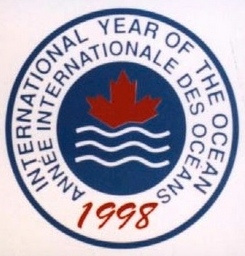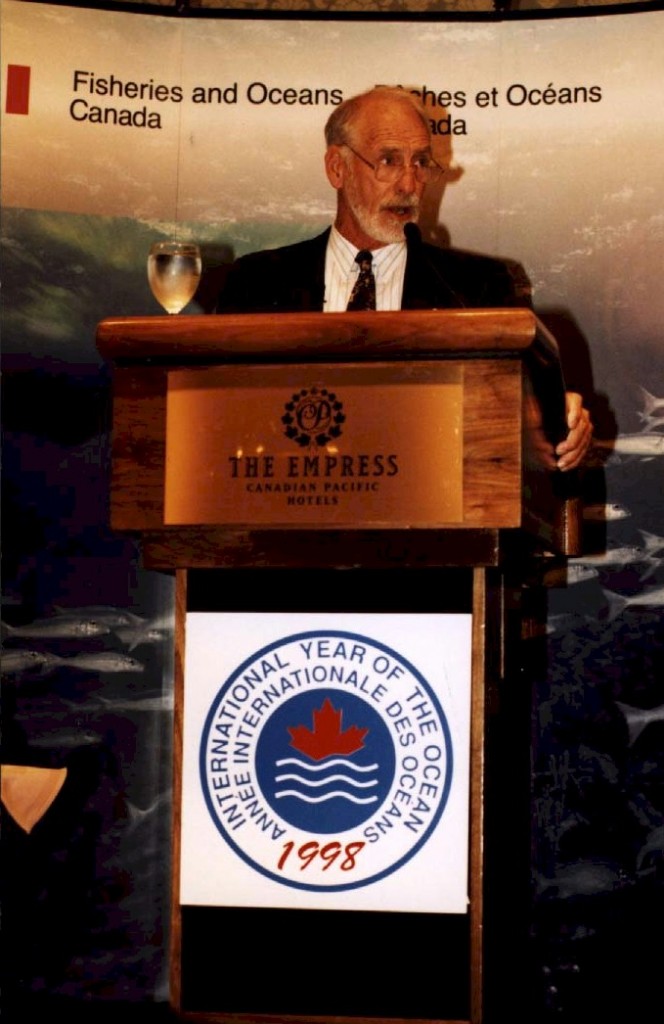 Canada became the first country in the world to adopt its own Oceans Act in 1997. In it there were constructive plans for the designation of Marine Protected Areas<
Canada became the first country in the world to adopt its own Oceans Act in 1997. In it there were constructive plans for the designation of Marine Protected Areas<
First Marine Protected Area Pilots Sept. 1, 1998
“Today at 1:30 pm. in Victoria, BC at a luncheon in the Empress Hotel in conjunction with the Coastal Zone Canada ‘ 98 Conference, The Honourable David Anderson , Minister of Fisheries and Oceans for Canada announced that Race Rocks and Gabriola Passage will become the first two 
Marine Protected Areas for the Pacific Coast of Canada. The minister emphasized that this was an historic occasion as it represents the first steps of many in creating these special areas for the conservation of marine resources. The two areas will serve as “Pilot MPA’s ” and represent the first of several areas to be designated in the three oceans of Canada. On hand for the announcement by the minister was Garry Fletcher, faculty member in biology and environmental systems at Lester Pearson College, along with many invited guests from the First Nations communities, environmental groups, provincial government officials, and other stake holders in the marine environment of British Columbia.
In the ensuing months, negotiations will take place with the ministry in order to set up the parameters of these new Marine Protected Area pilot study areas.
Statement by David Anderson
Minister of Fisheries and Oceans
This site was available on the DFO website at the following URL until 2007:
http://www-comm.pac.dfo-mpo.gc.ca/english/release/statement/1998/st9805e.htm
MARINE PROTECTED AREAS
I want to thank you all for joining me today for lunch. Victoria is my hometown, I was born here and have lived here for most of my life. So I feel very proud that I will be making Oceans history today in Victoria.
Here in British Columbia, we live in what I consider one of the most beautiful parts of the world. We enjoy a host of natural riches. Many of you heard my address on Sunday, during which I spoke about oceans and our need to conserve and protect them.
I spoke then of the growing need to protect the health and vitality of our marine resource base. Broad-ranging global issues, like those described eloquently on Sunday by Judith Swan in her keynote address, such as pollution, habitat alteration and loss, and over-exploitation of our oceans, are of growing concern.
Unfortunately, we too often overlook our collective responsibility to the ocean and its resources.
I said when I was appointed Minister of Fisheries and Oceans in June 1997 that I had three priorities as Minister: conservation, conservation, and conservation. I can tell you that is not always easy.
And if you watched the news over the past few days, as I know most of you do, you would think my mandate is strictly fisheries. But I am the Minister of Fisheries AND Oceans. And it is the OCEANS part of my mandate that I am here to speak about today.
When I addressed conference delegates on Sunday night, I talked about the oceans and the importance of the oceans to Canada and our way of life. I also talked about the International Year of the Ocean, and how we in Canada have adopted the United Nations’ stated goals for the year — to make people more aware of the ocean, to bring oceans-related issues to the forefront, and to build a lasting legacy of programs to conserve and protect the world’s oceans and oceans resources.
And I discussed Canada’s Oceans Act. This Act, passed in January 1997, gives the Minister of Fisheries and Oceans the lead in developing an Oceans Strategy for Canada. The Strategy will be based on the principles of the Oceans Act: integrated management, sustainable development and an ecosystem-based and precautionary approach.
On Oceans Day this year, I established a new Oceans Sector in my department to provide a clearer focus on oceans issues.
One of the tasks I have assigned this new team is the development, in collaboration with other federal agencies, other levels of government including First Nations, stakeholders, communities and the public, of a national network of Marine Protected Areas by the year 2000.
The Oceans Act provides me as Minister with the authority to designate areas for the conservation and protection of marine habitats and resources.
Over the past year, we have held extensive public consultations on our proposed approach to establishing Marine Protected Areas. In April of this year, I released a Policy regarding Marine Protected Areas and a national framework for establishing Marine Protected Areas.
Marine Protected Areas can be established, under Canada’s Oceans Act, for many different reasons, including the conservation and protection of:
- fisheries resources;
- endangered or threatened marine species and their habitats;
- unique habitats; and
- marine areas of high biodiversity or biological productivity.
Marine Protected Areas established under the Oceans Act must satisfy a range of needs in a variety of jurisdictional settings. As a result, we MUST take a flexible approach to their design and management.
The overall objective of the Marine Protected Areas program is to conserve and protect the ecological integrity of marine ecosystems, species, and habitats. At the same time, they will further the gathering of scientific knowledge and understanding and contribute to the sustainability of coastal communities.
We have adopted a “learn-by-doing” approach. This involves, as a first phase, the establishment of pilot MPA projects to provide practical experience in establishing and managing Marine Protected Areas.
Pilot MPA projects will be used to test various aspects of the MPA framework. For example, partnering opportunities and mechanisms will be explored; criteria for evaluating MPAs will be tested; minimum standards of protection will be examined; and opportunities for collaboration with other agencies, First Nations and other levels of government will be explored.
Learning from these pilot projects will be an integral part of the development of a national network of Marine Protected Areas.
For us in Canada, today is an historic moment.
Today I am pleased to announce that Fisheries and Oceans Canada, along with its federal and provincial partners, is establishing the first two pilot project Marine Protected Area projects in Canada here in the waters of our West Coast. These first two sites will be at Race Rocks and Gabriola Passage, here within view of the Coastal Zone Conference ‘98.
I expect to announce further pilot projects for all three coasts over the coming months. Taken together, these pilot projects will be a first step towards a network of Marine Protected Areas by the year 2000.
The pilot Marine Protected Area projects I am announcing today will provide an opportunity to learn and test different applications of MPA identification, assessment, legal designation and management. This will allow us to address the concerns of local first Nations. The lessons we learn from these will better enable us to establish and manage these areas in the future.
The aspect of the announcement today that I personally find most gratifying is the degree of cooperation and collaboration that has preceded this announcement.
My officials here in Pacific Region have been working closely with their colleagues both in Parks Canada and Environment Canada at the federal level and with the Ministry of Environment, Lands and Parks, the provincial Ministry of Fisheries, and the Land Use Coordination Office of the Province of British Columbia. Many representatives from all of these departments, both federal and provincial, are here today.
And I would like to acknowledge the growing number of citizens who are looking out at the sea and getting involved to protect it. Their involvement is critical.
I would like to make particular mention of First Nations involvement in Marine Protected Areas. The cultural values of First Nations are consistent with the values directing our work on Marine Protected Areas.
There are important needs of our First Nations that I would like to emphasize today.
First, the establishment of these two pilot areas will not affect First Nations opportunities to fish for food, social and ceremonial purposes.
Second, the development of Marine Protected Areas will be completely consistent with long-term direction toward future Treaties between first nations and the two levels of government — federal and provincial.
Finally, First Nations will be fully involved with the development of an effective decision-making process for Marine Protected Areas.
I have directed my Pacific Region officials to continue to meet with First Nations who have a direct interest in Gabriola Passage and Race Rocks.
I anticipate that our Provincial colleagues will play a significant role in consultations with First Nations, stakeholders and the public.
I would also like to emphasize that community support and involvement are crucial to the success of Marine Protected Areas.
Last Friday, a federal-provincial discussion paper titled “Marine Protected Areas, A Strategy for Canada’s Pacific Coast,” was released.
The paper reflects the common objectives of both governments for a more integrated approach to marine protection and conservation.
It also reflects extensive advice and feedback from local governments, First Nations, communities, stakeholders, industry and interested people gathered during a number of public fora and meetings over the past three years.
This on-going process will, I know, ensure the success of these pilot projects.
The hallmark of Marine Protected Areas is cooperation.
The announcement today is a testimony to what we all can achieve when they work together, in good faith, for a common and beneficial cause. We all have a stake in protecting the ocean, in order to ensure that its resources are sustained for our children and for their children.
Today we all give something back to the ocean.
This is a benchmark for cooperation amongst peoples. Let’s build on this experience and learn from it. And let’s put the benefits of our combined, cooperative efforts to use for the benefit of the oceans of the future.
The Marine Protected Areas program will provide us with a form of ecological insurance to conserve and protect oceans and ocean resources.
We need to learn from the past and pass on to our children a legacy of measures to protect the world’s oceans, which are the cornerstone of our survival on the planet. Marine Protected Areas will form a very important part of that legacy.
Today is a wonderful day for our oceans.
Thank you. (The Hon. David Anderson)
This site was available on the DFO website at the following URL until 2007:
http://www-comm.pac.dfo-mpo.gc.ca/english/release/statement/1998/st9805e.htm
See also: DFO Backgrounder Race Rocks XwaYeN: A Success Story for Community and Stakeholder Involvement,
In January of 1999, as part of the requirements of the Marine Protected Areas Pilot review process, Garry Fletcher was contracted by Fisheries and Oceans Canada to complete The Race Rocks Ecological Overview. An MS Acccess metadatabase of all the relevant Race Rocks ecological information was assembled . This database and accompanying references and audiovisual material are now available in the library at Lester B. Pearson College.
